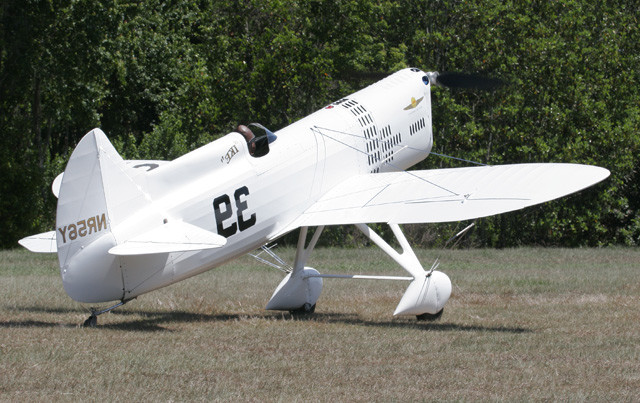
1932 DGA-5 “IKE”
As a young man, Benjamin O’Dell Howard was never one to seek conventional education, so with a how-to-fly book and a second-hand biplane, he experienced his first flight . . . quickly followed by his first crash. Undaunted, he rejected a high-paying job to work from the ground up at the Curtiss factory, where he learned hands-on about aircraft design and building. By the age of 20, he designed and built his first aircraft. What followed was a wildly colorful, Golden Age career, modifying aircraft for bootleggers and chasing racing prizes during the romantic ‘20s and ‘30s. Each aircraft Benny built was identified with his own official trademark, DGA, which stands for “Da*ned Good Airplane.”
In partnership with Gordon Israel, Benny created two of the smallest and quickest aircraft in the 1932 races: low-wing wire-braced monoplanes known as “Mike” and “Ike,” who took turns being the faster. After Benny and Gordon added a third aircraft, “Mr. Mulligan,” to the stable, prize money and acclaim poured in, culminating in 1935 when Howard aircraft won the Bendix, Thompson, and Greve Trophy—a season of racing events that became unofficially known as the “Benny Howard National Air Races.” Benny claimed he preferred building racing planes because they “paid for themselves,” but his legacy was bigger than trophies. Howard’s aircraft were among the safest in the hell-bent-for-leather races, never killing a pilot. And while many of the original classic racers—including all the GeeBees—are long gone, Howard’s original “Ike” and “Mike” are still preserved.
“Ike” appears in All of Life is a School as the character Benny, a shy but gifted racing plane who enjoys the company of Zee and the gang.
Specifications
- Year Built — 1932 (2004 Reproduction)
- Wingspan — 20’1″
- Length — 17’2.5″
- Cruise Speed — Cruise Speed — 175 mph
- Top Speed — Top Speed — 241.6 mph
- Gross Weight — 1,194 lbs
- Original Engine — Menasco Buccaneer B6 160 hp (adjustable to 200)
- Current Engine — Menasco D4-87 Pirate 134 hp
Kermit’s Comments
I first saw this aircraft several years ago at the EAA Oshkosh Fly-In and made a note I should acquire it one day. To my surprise, its builder Kim Kovach, wanting to see it go to a good home, actually contacted me! In order to be sure I could get in it, I stopped by for an inspection and found I just barely fit! To make the smallest possible frontal area, Benny designed the cockpit so that the heels of the pilot and seat bottom actually dip below the cockpit floorboards! Measuring the original aircraft for exact dimensions, Kim made only one modification: extending the upper fuselage width at the instrument panel back to the top of the pilots seat. Had he not continued this extra 3 inches back, I would not have fit, as the original shoulder width was only a mere 15 inches! Perhaps the future acquisition of this Golden Age “character” was meant to be!